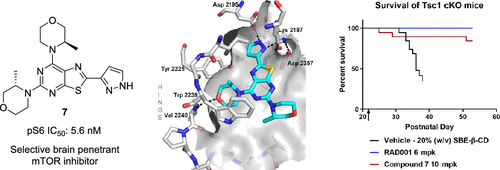当前位置:
X-MOL 学术
›
J. Med. Chem.
›
论文详情
Our official English website, www.x-mol.net, welcomes your feedback! (Note: you will need to create a separate account there.)
Discovery of a Brain-Penetrant ATP-Competitive Inhibitor of the Mechanistic Target of Rapamycin (mTOR) for CNS Disorders.
Journal of Medicinal Chemistry ( IF 7.3 ) Pub Date : 2020-01-31 , DOI: 10.1021/acs.jmedchem.9b01398 Simone Bonazzi 1 , Carleton P Goold 2 , Audrey Gray 2 , Noel M Thomsen 1 , Jill Nunez 1 , Rajeshri G Karki 1 , Aakruti Gorde 2 , Jonathan D Biag 2 , Hasnain A Malik 1 , Yingchuan Sun 1 , Guiqing Liang 3 , Danuta Lubicka 4 , Sarah Salas 2 , Nancy Labbe-Giguere 1 , Erin P Keaney 1 , Stephanie McTighe 2 , Shanming Liu 5 , Lin Deng 3 , Grazia Piizzi 1 , Franco Lombardo 3 , Doug Burdette 3 , Jean-Cosme Dodart 2 , Christopher J Wilson 2 , Stefan Peukert 1 , Daniel Curtis 2 , Lawrence G Hamann 1 , Leon O Murphy 5
Journal of Medicinal Chemistry ( IF 7.3 ) Pub Date : 2020-01-31 , DOI: 10.1021/acs.jmedchem.9b01398 Simone Bonazzi 1 , Carleton P Goold 2 , Audrey Gray 2 , Noel M Thomsen 1 , Jill Nunez 1 , Rajeshri G Karki 1 , Aakruti Gorde 2 , Jonathan D Biag 2 , Hasnain A Malik 1 , Yingchuan Sun 1 , Guiqing Liang 3 , Danuta Lubicka 4 , Sarah Salas 2 , Nancy Labbe-Giguere 1 , Erin P Keaney 1 , Stephanie McTighe 2 , Shanming Liu 5 , Lin Deng 3 , Grazia Piizzi 1 , Franco Lombardo 3 , Doug Burdette 3 , Jean-Cosme Dodart 2 , Christopher J Wilson 2 , Stefan Peukert 1 , Daniel Curtis 2 , Lawrence G Hamann 1 , Leon O Murphy 5
Affiliation

|
Recent clinical evaluation of everolimus for seizure reduction in patients with tuberous sclerosis complex (TSC), a disease with overactivated mechanistic target of rapamycin (mTOR) signaling, has demonstrated the therapeutic value of mTOR inhibitors for central nervous system (CNS) indications. Given that everolimus is an incomplete inhibitor of the mTOR function, we sought to develop a new mTOR inhibitor that has improved properties and is suitable for CNS disorders. Starting from an in-house purine-based compound, optimization of the physicochemical properties of a thiazolopyrimidine series led to the discovery of the small molecule 7, a potent and selective brain-penetrant ATP-competitive mTOR inhibitor. In neuronal cell-based models of mTOR hyperactivity, 7 corrected the mTOR pathway activity and the resulting neuronal overgrowth phenotype. The new mTOR inhibitor 7 showed good brain exposure and significantly improved the survival rate of mice with neuronal-specific ablation of the Tsc1 gene. These results demonstrate the potential utility of this tool compound to test therapeutic hypotheses that depend on mTOR hyperactivity in the CNS.
中文翻译:

雷帕霉素(mTOR)的中枢神经系统疾病的机械目标的脑渗透ATP竞争性抑制剂的发现。
依维莫司最近用于减少结节性硬化症(TSC)患者的癫痫发作的临床评估,结节性硬化症是雷帕霉素(mTOR)信号的机械作用靶过度活化的疾病,证明了mTOR抑制剂对中枢神经系统(CNS)适应症的治疗价值。鉴于依维莫司是mTOR功能的不完全抑制剂,我们寻求开发一种新的mTOR抑制剂,该抑制剂具有改善的性能并适用于中枢神经系统疾病。从内部基于嘌呤的化合物开始,优化噻唑并嘧啶系列的理化特性导致发现了小分子7,这是一种有效且选择性的脑渗透性ATP竞争性mTOR抑制剂。在基于神经元细胞的mTOR多动症模型中,7纠正了mTOR通路的活性以及由此产生的神经元过度生长的表型。新的mTOR抑制剂7表现出良好的大脑暴露能力,并显着提高了Tsc1基因神经元特异性消融小鼠的存活率。这些结果证明了该工具化合物在测试依赖于CNS中mTOR多动症的治疗假设方面的潜在实用性。
更新日期:2020-01-31
中文翻译:

雷帕霉素(mTOR)的中枢神经系统疾病的机械目标的脑渗透ATP竞争性抑制剂的发现。
依维莫司最近用于减少结节性硬化症(TSC)患者的癫痫发作的临床评估,结节性硬化症是雷帕霉素(mTOR)信号的机械作用靶过度活化的疾病,证明了mTOR抑制剂对中枢神经系统(CNS)适应症的治疗价值。鉴于依维莫司是mTOR功能的不完全抑制剂,我们寻求开发一种新的mTOR抑制剂,该抑制剂具有改善的性能并适用于中枢神经系统疾病。从内部基于嘌呤的化合物开始,优化噻唑并嘧啶系列的理化特性导致发现了小分子7,这是一种有效且选择性的脑渗透性ATP竞争性mTOR抑制剂。在基于神经元细胞的mTOR多动症模型中,7纠正了mTOR通路的活性以及由此产生的神经元过度生长的表型。新的mTOR抑制剂7表现出良好的大脑暴露能力,并显着提高了Tsc1基因神经元特异性消融小鼠的存活率。这些结果证明了该工具化合物在测试依赖于CNS中mTOR多动症的治疗假设方面的潜在实用性。



























 京公网安备 11010802027423号
京公网安备 11010802027423号